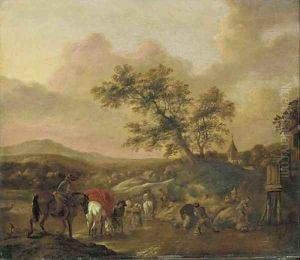Phillips Wouwermans Paintings
Philips Wouwerman was a prolific and influential Dutch painter born in Haarlem, Netherlands, in 1619. He descended from a family deeply embedded in the arts; his father, Paulus Joosten Wouwerman, was a painter as well. Despite the artistic environment he grew up in, little is documented about Philips' early life and training. It is believed he initially trained under his father before possibly studying with Frans Hals, a leading Dutch master of the time, though direct evidence linking him to Hals' workshop is scarce. Some scholars also suggest that Wouwerman traveled to Germany, France, and Italy, which was a common practice among artists of his era, to broaden his artistic horizons, although concrete details of these journeys remain elusive.
Wouwerman's work primarily focused on landscapes, battle scenes, and genre scenes incorporating horses, which became his most recognizable motif. He was exceptionally skilled in depicting horses of various breeds and in different states of action, which made his works highly sought after during his lifetime and beyond. His landscapes often featured elegant, aristocratic figures engaging in leisure activities, hunting scenes, and military camps, rendered with exquisite detail and atmospheric effects. Wouwerman's palette was notably delicate, favoring soft blues, greens, and earth tones that contributed to the serene and harmonious quality of his compositions.
Despite beginning his career during the Thirty Years' War (1618–1648), a period marked by economic and social turmoil, Wouwerman achieved significant commercial success. He became a member of the Haarlem Guild of St. Luke in 1640, which was instrumental for his career, allowing him to sell his paintings and take on students. Over his lifetime, he produced a vast body of work, with estimates suggesting he painted over 800 paintings, although not all are extant or attributed to him with certainty due to the frequent misattribution of his works to other artists, both contemporaries and followers.
Philips Wouwerman's influence extended well beyond his death in 1668, with his brother Pieter and other followers continuing his tradition. His works were collected extensively throughout Europe, especially in France and Germany, during the 18th century, and they influenced subsequent generations of painters. Today, his paintings are held in many major museums around the world, testament to his enduring appeal and significance in the history of art.
